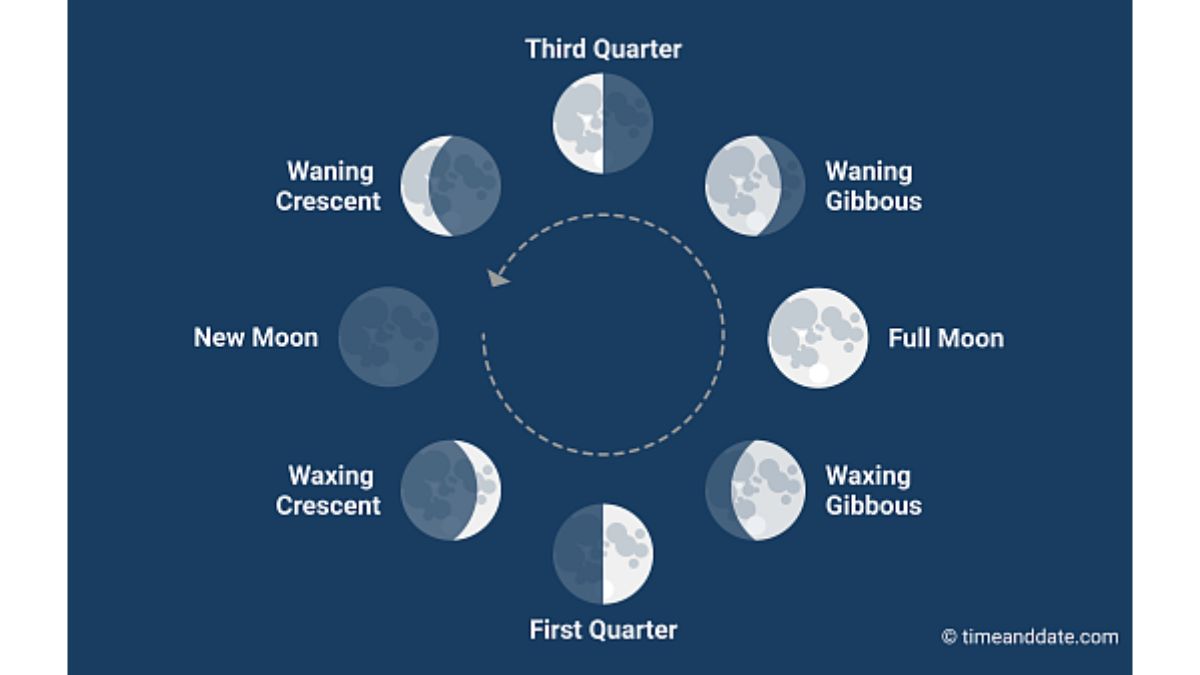Lunar Eclipse 2023: On May 5, a full moon day, the first lunar eclipse of the year will occur. While the full Moon will be visible for three days, from early Thursday morning to early Sunday morning, only people in Africa, Asia, and Australia will be able to see the penumbral lunar eclipse. This full moon is also referred to as the Flower Moon, Corn Moon, Corn Planting Moon, Milk Moon, and Hare's Moon.
The various phases or varieties of the Moon are discussed in this article. Discover all eight lunar phases, four primary and four intermediate below:
 Source: Time and Date
Source: Time and Date
New Moon
New Moon nights are typically the ideal times to view planets, meteor showers, and deep-sky objects like star clusters, nebulae, and galaxies since they are so dark.
Every day, the amount of that light that we can see from Earth varies; we refer to this as the Moon's phase. Except during Chandragrahanam, when the Moon is hidden by Earth's shadow, half of the Moon's surface is always exposed to direct sunlight. Do you know about the difference between Solar and Lunar Eclipse?
Waxing Crescent Moon
After the New Moon conjunction, when the Sun and Earth are on opposite sides of the Moon and it is impossible to see the Moon from Earth, the Moon starts to become visible again, this marks the beginning of the Waxing Crescent Moon. The percentage of the Moon that is lit up during this phase rises from 0.1% to 49.9%.
Waxing denotes growth, while the crescent describes the sickle-shaped curve. With few exceptions, the Waxing Crescent Moon rises throughout the day before noon and becomes visible in the day sky. It becomes more noticeable around sunset, but it usually sets before midnight.
The First Quarter Moon
Apart from the Sun, the Moon is the only astronomical object that can be seen clearly in the daytime sky. Midday is when the First Quarter Moon rises, and midnight is when it sets. This is the opposite of a Third Quarter Moon, which rises in the midst of the night and sets in the middle of the day.
Except during lunar eclipses, when the Moon is hidden by Earth's shadow, half of the Moon's surface is always exposed to direct sunlight. Every day, the amount of that light that we can see from Earth varies which basically refers to the Moon's phase.
Waxing Gibbous Moon
Gibbous refers to the oval to a circular shape, whereas waxing denotes that it is growing in size. The difference between Waxing Gibbous and Full Moon is very minute, as the illuminated portion increases to 98–99%. The Waxing Gibbous Moon rises in the afternoon, with few exceptions. Typically, it can be seen in the evening and disappears after midnight.
When the Moon is in the Waxing Gibbous phase, its illuminated area increases from 50.1% to 99.9%. Up till the Full Moon, which lasts from the time right after the First Quarter Moon.
Full Moon
The most beautiful Moon phase is the full moon when the Moon is fully illuminated. The Moon is fully lit by the Sun when the Sun and Moon are positioned so that they are on opposite sides of the Earth.
Some Full Moons, according to Time and Date, are only 99.9% illuminated from Earth. Because the Moon's orbit around Earth is inclined at an angle of about 5° in relation to the Earth's orbital plane, the ecliptic, we sometimes cannot see the entire illuminated hemisphere of the Moon during Full Moons.
Waning Gibbous Moon
Gibbous refers to the oval to-round shape, whilst waning denotes a shrinking and enlarging. When the Moon is in the Waning Gibbous phase, its illuminated area decreases from 99.9% to 50.1%. Up till the third quarter moon, it lasts from the time shortly after the full moon.
When 98%–99% of the surface is lighted, it might be difficult to tell the initial stage of a Waning Gibbous from a Full Moon. Aside from that, the Waning Gibbous Moon rises after sunset but before midnight and sets after sunrise.
Third Quarter Moon
Except for lunar eclipses, when Earth casts its shadow on the Moon, the Moon's surface is always half-lit by direct sunlight. We refer to these daily variations in the amount of that light that we can see from Earth as the Moon phases. Due to the Sun's light shining on exactly 50% of the Moon's surface, the Third or Last Quarter Moon is also known as a Half Moon.
Waning Crescent Moon
Waning refers to a shape that is contracting and getting smaller, whereas crescent describes a sickle-shaped curve. Half of the Moon is always illuminated by sunlight as a result of the Moon's surface reflecting the Sun's beams. We refer to this as a Moon phase since it varies daily how much of that light we can see from Earth.
The Moon will pass through the Earth's penumbra, or partial shadow, during this modest celestial occurrence, generating a tiny dimming that may go missed by casual viewers.
This year will see two solar eclipses and two lunar eclipses for a total of four eclipses. On April 20, there was a hybrid solar eclipse, which was the first one. A second annular solar eclipse, which is rarer, will occur on October 14. The first lunar eclipse of the year, a penumbral lunar eclipse, will occur on May 5. The final lunar eclipse of the year, a partial eclipse, will occur on October 28.
Source: Time and Date
Comments
All Comments (0)
Join the conversation